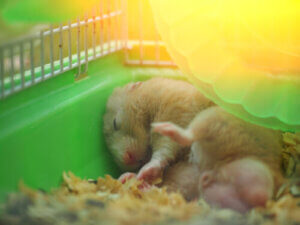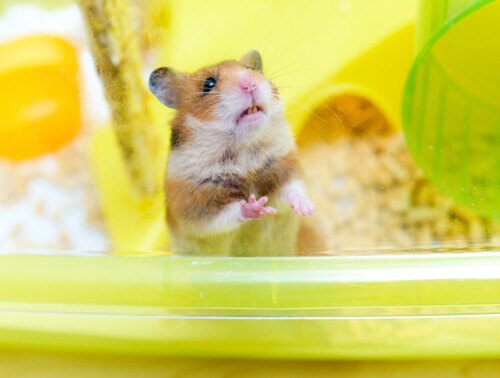How to Prevent Heat Stroke in Hamsters

During the summer months, pets are exposed to the after-effects of staying in a closed room at high temperatures for long periods of time. Heat stroke in hamsters can be especially dangerous to their health.
How to know if a hamster is close to getting heat stroke
When an animal is exposed to high temperatures, its metabolism slows down. This results in a decrease in their physical activity and overall energy level, as well as mood swings.
A hamster that begins to feel the effects of excessive heat will also lose its appetite, which may lead to weight loss. If this lack of activity and desire to eat is prolonged and intensifies, you may need to take your pet to the vet.

One of the most worrying symptoms your pet may experience as an immediate consequence of heat stroke is floppiness. If you notice that your rodent is lying on its stomach as if it’s playing dead, take it to the vet right away.
Preventing heat stroke in hamsters
As a responsible pet owner, it’s your obligation to do everything possible to take care of your pet’s health. The key is always prevention; this way you’ll avoid potential scares and physical problems for your hamster.
Since your pet’s habitat is your home, the first thing you should do is make sure the animal is as comfortable as possible. Its environment, as well as the healthy living habits you decide to implement in its routine, can protect your hamster against numerous issues.

However, no prevention method is enough on its own; it needs to be practiced in conjunction with others. Keep this in mind before choosing methods to avoid potential scares from the list below.
Ways to protect your hamster
- Where you put your pet’s cage will have a big influence on the ambient temperature. Try to move the cage as the season changes. In winter it’s wise to place your hamster in a sheltered, warm place; however in summer you’ll need to avoid direct contact with sunlight and make sure the cage stays cool and dry.
- If your house doesn’t have good air conditioning and you’re afraid your pet might suffer heat stroke no matter where you put the cage, remember that water is always your best ally. Make sure your hamster has fresh water at all times. In addition, if you see that the temperature is climbing, use a spray bottle to humidify and cool its cage.
- Hamsters can eat fruit and vegetables, so consider incorporating water-rich foods, such as watermelon, cucumber, and melon into their diet instead of only feeding them store-bought feed or seeds.
- Remember that your hamster’s immediate environment is its cage. As such, it’s very important that you choose a well-ventilated model, such as one that has wire netting, and avoid plastic and glass cages.
However, certain animals are more prone to heat stroke; sometimes it’s difficult to prevent if your hamster is more sensitive than usual. If you notice that your pet is lethargic, is eating less, and is thinner, then consult a veterinarian.
During the summer months, pets are exposed to the after-effects of staying in a closed room at high temperatures for long periods of time. Heat stroke in hamsters can be especially dangerous to their health.
How to know if a hamster is close to getting heat stroke
When an animal is exposed to high temperatures, its metabolism slows down. This results in a decrease in their physical activity and overall energy level, as well as mood swings.
A hamster that begins to feel the effects of excessive heat will also lose its appetite, which may lead to weight loss. If this lack of activity and desire to eat is prolonged and intensifies, you may need to take your pet to the vet.

One of the most worrying symptoms your pet may experience as an immediate consequence of heat stroke is floppiness. If you notice that your rodent is lying on its stomach as if it’s playing dead, take it to the vet right away.
Preventing heat stroke in hamsters
As a responsible pet owner, it’s your obligation to do everything possible to take care of your pet’s health. The key is always prevention; this way you’ll avoid potential scares and physical problems for your hamster.
Since your pet’s habitat is your home, the first thing you should do is make sure the animal is as comfortable as possible. Its environment, as well as the healthy living habits you decide to implement in its routine, can protect your hamster against numerous issues.

However, no prevention method is enough on its own; it needs to be practiced in conjunction with others. Keep this in mind before choosing methods to avoid potential scares from the list below.
Ways to protect your hamster
- Where you put your pet’s cage will have a big influence on the ambient temperature. Try to move the cage as the season changes. In winter it’s wise to place your hamster in a sheltered, warm place; however in summer you’ll need to avoid direct contact with sunlight and make sure the cage stays cool and dry.
- If your house doesn’t have good air conditioning and you’re afraid your pet might suffer heat stroke no matter where you put the cage, remember that water is always your best ally. Make sure your hamster has fresh water at all times. In addition, if you see that the temperature is climbing, use a spray bottle to humidify and cool its cage.
- Hamsters can eat fruit and vegetables, so consider incorporating water-rich foods, such as watermelon, cucumber, and melon into their diet instead of only feeding them store-bought feed or seeds.
- Remember that your hamster’s immediate environment is its cage. As such, it’s very important that you choose a well-ventilated model, such as one that has wire netting, and avoid plastic and glass cages.
However, certain animals are more prone to heat stroke; sometimes it’s difficult to prevent if your hamster is more sensitive than usual. If you notice that your pet is lethargic, is eating less, and is thinner, then consult a veterinarian.
This text is provided for informational purposes only and does not replace consultation with a professional. If in doubt, consult your specialist.








